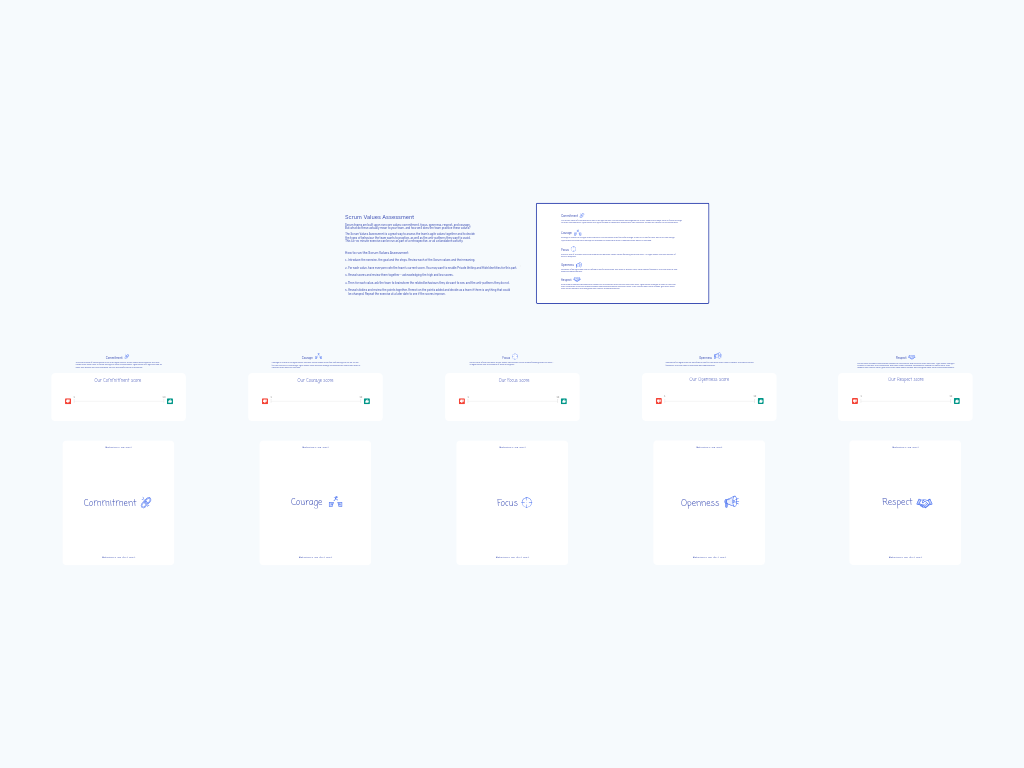Scrum Values Assessment
The Scrum Values Assessment is a powerful tool for agile teams to evaluate how well they embody the five core Scrum values: commitment, courage, focus, openness, and respect. This collaborative exercise helps teams identify specific behaviors they want to cultivate and eliminate, creating a shared understanding of what these values look like in practice.
What Is the Scrum Values Assessment?
The Scrum Values Assessment provides a structured framework for teams to reflect on their alignment with Scrum values—the foundation of effective agile teamwork. Rather than treating these values as abstract concepts, this assessment makes them tangible by having team members score their current performance and identify specific behaviors that demonstrate (or contradict) each value.
This exercise serves two important purposes: it creates awareness about how well the team currently embodies these values, and it establishes clear expectations about desired behaviors moving forward. By bringing these discussions into the open, teams can make intentional improvements to their working relationships and agile practices.
Benefits & When to Use
This assessment is particularly valuable when:
- A team is newly formed and establishing working agreements
- Team dynamics have changed (new members, new project, reorganization)
- The team feels disconnected from agile principles
- Sprint retrospectives reveal interpersonal or process challenges
- You want to check progress on previous cultural improvement goals
Key benefits include:
- Creating a shared vocabulary around team behaviors
- Revealing misalignments in how team members perceive their interactions
- Identifying specific, actionable improvements to team culture
- Building psychological safety through honest discussions
- Providing a benchmark for measuring team growth over time
How to Run a Scrum Values Assessment Session
Time required: 60-90 minutes
Introduction (10 minutes)
- Explain the purpose of the exercise: to assess how well the team embodies Scrum values and identify specific behaviors to adopt or avoid
- Review each Scrum value and its meaning (commitment, courage, focus, openness, respect)
- Clarify that the goal is improvement, not judgment
Individual Assessment (15 minutes)
- For each value, have team members individually rate the team's current performance on a scale of 1-10
- Enable Private Writing and Hide Identities features to encourage honesty
- Ask members to consider specific examples that inform their ratings
Score Review (15 minutes)
- Reveal all scores for each value
- Discuss patterns, noting which values scored highest and lowest
- Explore reasons for any significant differences in perception (high variance in scores)
- Avoid blaming individuals; focus on the team as a system
Behavior Brainstorming (20-30 minutes)
- For each value (starting with the lowest-scored ones), have the team brainstorm:
- Specific behaviors that demonstrate the value ("Behaviors we want")
- Anti-patterns that contradict the value ("Behaviors we don't want")
- Encourage specificity: "We respect each other's time" is less useful than "We start and end meetings on time"
- For each value (starting with the lowest-scored ones), have the team brainstorm:
Reflection and Commitment (10-20 minutes)
- Review all identified behaviors as a team
- Identify 2-3 behaviors to focus on improving before the next assessment
- Discuss how the team will hold itself accountable
- Schedule a follow-up assessment (typically 2-3 months later) to measure improvement
Tips for a Successful Session
- Focus on behaviors, not individuals: Frame discussions around "what we do" rather than "who does what."
- Be specific: Vague descriptions of values are difficult to act upon. Push for concrete examples.
- Encourage psychological safety: Acknowledge that perfect scores aren't the goal and that honest reflection is more valuable than artificially high ratings.
- Connect to daily work: Relate each value to actual sprint activities and team interactions that occur regularly.
- Consider recurring assessments: Run this exercise quarterly to track progress and refocus improvement efforts.
- Start small: If improvement areas seem overwhelming, focus on just one value to improve first.
- Revisit during retrospectives: Briefly check in on the targeted behaviors during regular sprint retrospectives.
By regularly assessing and discussing these values, remote dev teams can create stronger bonds, improve collaboration, and ultimately deliver better results for their stakeholders.



